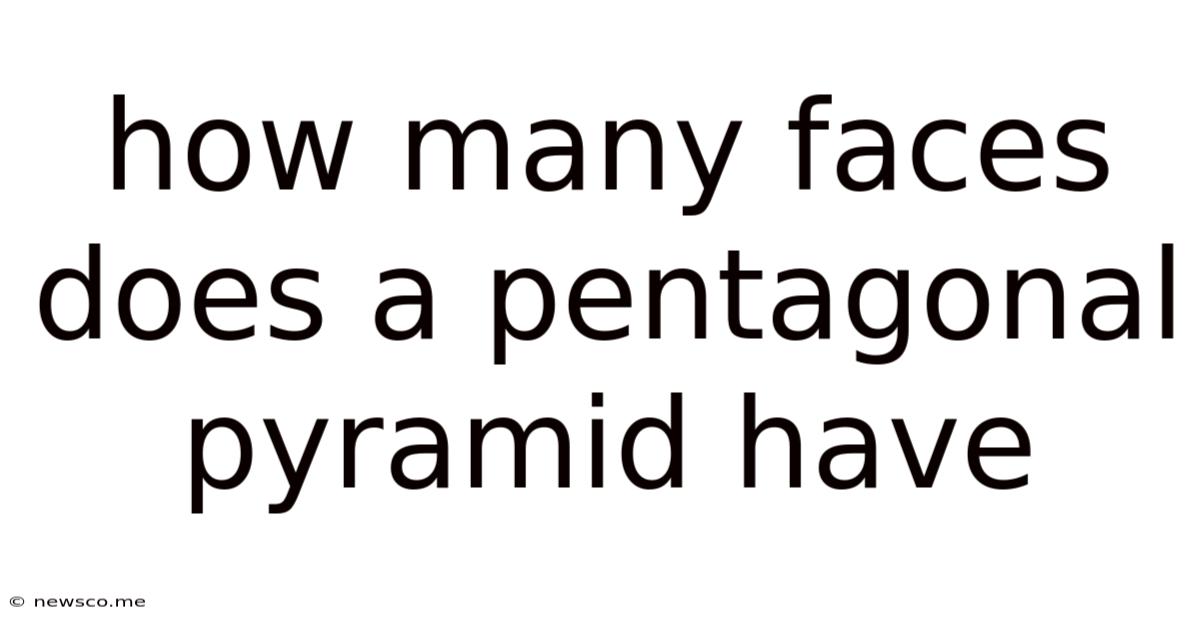How Many Faces Does A Pentagonal Pyramid Have
News Co
Mar 19, 2025 · 5 min read

Table of Contents
How Many Faces Does a Pentagonal Pyramid Have? A Comprehensive Exploration of Geometric Solids
Understanding the geometry of three-dimensional shapes is fundamental to various fields, from architecture and engineering to computer graphics and mathematics. One such shape, the pentagonal pyramid, often sparks curiosity about its components. This article delves into the intricacies of the pentagonal pyramid, specifically addressing the question: how many faces does a pentagonal pyramid have? We'll explore its properties, variations, and applications, ensuring a comprehensive understanding suitable for students, educators, and anyone fascinated by the world of geometry.
Defining the Pentagonal Pyramid
Before tackling the face count, let's establish a clear definition. A pentagonal pyramid is a three-dimensional geometric solid composed of a pentagonal base and five triangular faces that meet at a single apex (the top point). The pentagonal base is a polygon with five sides and five angles. The term "pentagonal" directly indicates this five-sided base. The critical aspect here is that each of the five sides of the base connects to a triangular face.
Counting the Faces: A Step-by-Step Approach
Now, let's answer the central question: How many faces does a pentagonal pyramid have?
The answer is six. This is derived from the two distinct types of faces that comprise the pyramid:
- The Pentagonal Base: This forms one of the faces.
- Five Triangular Faces: Each of the five sides of the pentagonal base is connected to a triangular face, creating a total of five triangular faces.
Therefore, adding the pentagonal base (1 face) and the five triangular faces (5 faces) gives a grand total of six faces for a pentagonal pyramid.
Visualizing the Faces: A Practical Approach
Understanding the structure visually aids in grasping the concept. Imagine constructing a pentagonal pyramid using cardboard or paper. You would need one piece of cardboard cut into the shape of a pentagon for the base and five separate triangular pieces to form the lateral faces. Assembling these pieces would create a complete pentagonal pyramid demonstrating its six distinct faces.
Understanding Related Geometric Terms: Faces, Edges, and Vertices
To further solidify our understanding, let's review other key geometric terms associated with three-dimensional shapes, particularly in the context of the pentagonal pyramid:
- Faces: These are the flat surfaces of the solid. In a pentagonal pyramid, we have already established that there are six faces – one pentagonal base and five triangular faces.
- Edges: These are the line segments where two faces meet. A pentagonal pyramid has ten edges: five edges forming the pentagonal base, and five edges connecting the base to the apex.
- Vertices: These are the points where three or more edges intersect. A pentagonal pyramid possesses six vertices: five vertices forming the corners of the pentagonal base, and one vertex at the apex.
Euler's Formula: A Mathematical Relationship
Euler's formula provides a fundamental relationship between the faces (F), vertices (V), and edges (E) of any convex polyhedron (a three-dimensional shape with flat faces). The formula is:
F + V - E = 2
Let's apply this to the pentagonal pyramid:
- F (Faces): 6
- V (Vertices): 6
- E (Edges): 10
Plugging these values into Euler's formula:
6 + 6 - 10 = 2
The equation holds true, confirming the accuracy of our face count and highlighting the consistency of geometric principles.
Variations and Generalizations: Beyond the Regular Pentagonal Pyramid
While we've focused on a regular pentagonal pyramid (where the base is a regular pentagon and the triangular faces are congruent), it's important to note that variations exist. An irregular pentagonal pyramid could have a base that is not a regular pentagon, or the triangular faces might not be congruent. However, the fundamental principle remains the same: a pentagonal pyramid, regardless of its regularity, will always have six faces.
Applications of Pentagonal Pyramids: Real-World Examples
Understanding the geometry of pentagonal pyramids extends beyond theoretical mathematics. These shapes find applications in various fields:
- Architecture: While not as prevalent as other shapes, elements of pentagonal pyramid geometry can be found in certain architectural designs, particularly in creating unique roof structures or decorative elements.
- Engineering: In structural engineering, understanding the strength and stability of various geometric shapes, including pentagonal pyramids, is crucial for building robust and efficient structures.
- Computer Graphics and Game Design: Modeling and rendering pentagonal pyramids (and more complex shapes incorporating pentagonal pyramids) are common tasks in computer graphics and game design, creating realistic and visually appealing three-dimensional environments.
- Crystallography: The study of crystals often involves identifying and classifying different crystal structures, some of which exhibit pentagonal pyramidal features.
Expanding Knowledge: Exploring Other Polyhedra
Understanding pentagonal pyramids is a stepping stone to understanding a wider range of three-dimensional shapes. Exploring other polyhedra, such as tetrahedrons, cubes, octahedrons, and dodecahedrons, helps build a stronger foundation in geometry and spatial reasoning. Each shape has unique characteristics regarding faces, edges, and vertices, all governed by fundamental geometric principles.
Conclusion: A Solid Understanding of the Pentagonal Pyramid
We've thoroughly explored the question of how many faces a pentagonal pyramid has, concluding definitively that it has six faces: one pentagonal base and five triangular faces. This seemingly simple question opens a gateway to a richer understanding of geometry, touching upon fundamental concepts like Euler's formula, regular versus irregular shapes, and practical applications in various fields. By grasping these concepts, we can appreciate the elegance and utility of geometric shapes in the world around us. Further exploration of geometric solids will enhance your spatial reasoning and problem-solving skills.
Latest Posts
Related Post
Thank you for visiting our website which covers about How Many Faces Does A Pentagonal Pyramid Have . We hope the information provided has been useful to you. Feel free to contact us if you have any questions or need further assistance. See you next time and don't miss to bookmark.